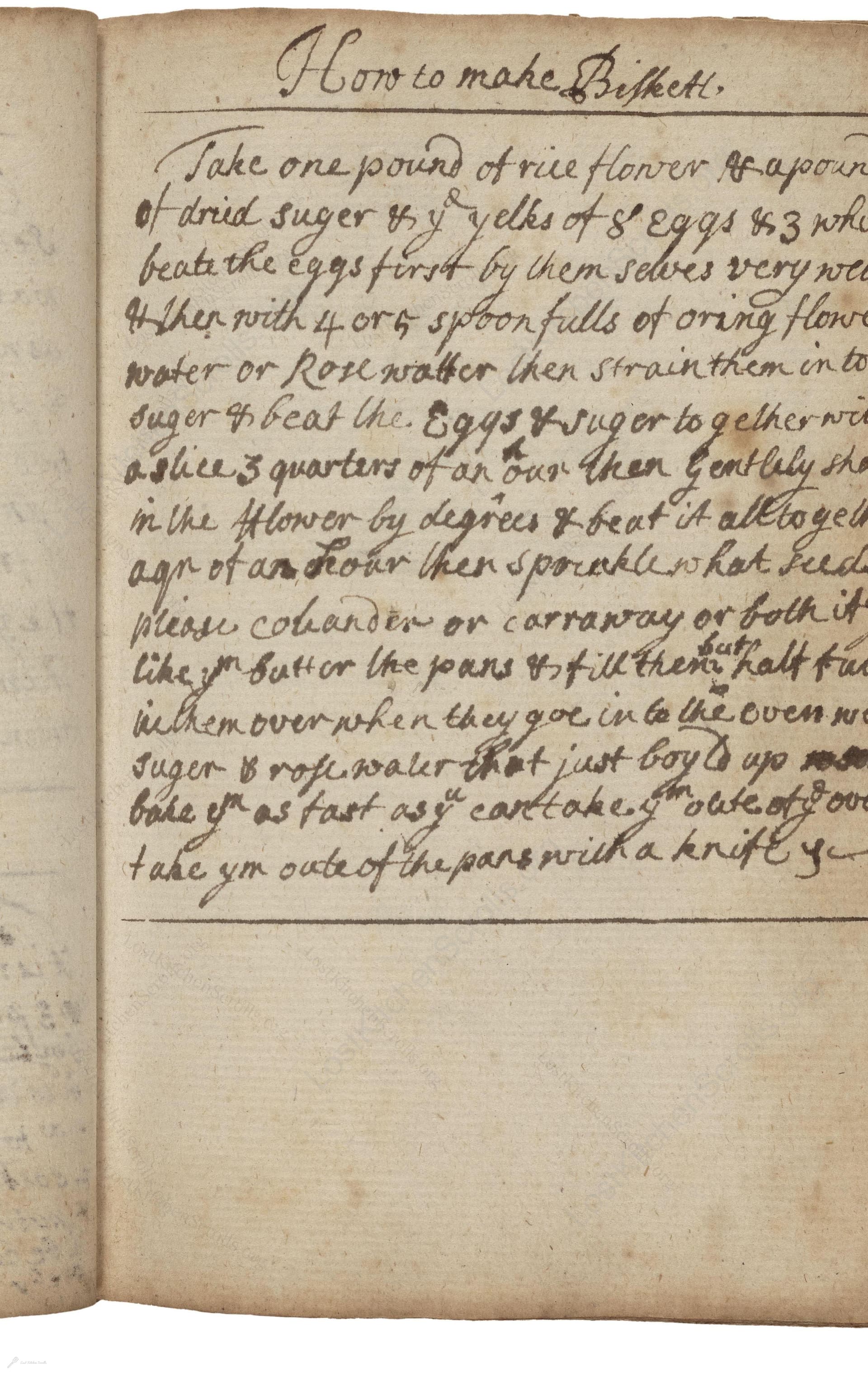How To Make Biskett
From the treasured pages of Medicinal and cookery recipes of Mary Baumfylde
Written by Mary Baumfylde

How To Make Biskett
"Take one pound of rice Flower & a pound of drid suger & y yelks of 8 Eggs & 3 whites beate the Eggs first by them selves very well & then with 4 or 5 spoon fulls of oring Flower water or Rose water then strain them in to the suger & beat the Eggs & suger to gether with aslice 3 quarters of an our then Gently shake in the Flower by degrees & beat it all to gether agr of an & hour then sprokle what seeds u th please cohander or carraway or both if youd like ym butterr the pans & fill them half full & them over when they goe in to the oven with d suger & rose water that just boyld up so so bake ym as fast as y can take ym oute of the pans with a knift yc—"
Note on the Original Text
Mary Baumfylde’s recipe is written in the loose, conversational style of early modern manuscript cookery. There are no precise times or temperatures; instead, a cook’s experience and sense of timing dictated success, as seen in instructions like 'beat it...three quarters of an hour.' Spelling is fluid—'flower' for flour, 'suger' for sugar, and 'oring' for orange—in part because English spelling wasn’t yet standardized and literacy was spreading. Punctuation is sparse, and fragmented lines mirror the informal, oral culture of the kitchen.

Title
Medicinal and cookery recipes of Mary Baumfylde (1626)
You can also click the book image above to peruse the original tome
Writer
Mary Baumfylde
Era
1626
Publisher
Unknown
Background
A sumptuous journey into early 17th-century English cookery, this delightful volume offers a tantalizing glimpse into the recipes, flavors, and culinary secrets that once graced aristocratic tables. Prepare for a taste of history, presented with wit and wisdom!
Kindly made available by
Folger Shakespeare Library
This recipe for 'biskett' comes from Mary Baumfylde, active in the early 17th century. Dated between 1626 and 1758, it offers a fascinating glimpse into English home baking before the rise of mass-produced cakes and biscuits. Such recipes were often manuscript treasures, passed down through families, reflecting both Continental influences and local innovations. Biscuits like this were delicate treats, often flavored with exotic flower waters and spices, served at well-to-do tables with tea or cordial.

In the historical kitchen, bisketts would have been made with basic but sturdy tools: large ceramic or pewter bowls for mixing, a whisk (likely made of bundles of twigs or even birch rods), metal or stone mortars for grinding sugar, and hand-sieves for flour. Baking pans would be of tin or thick pottery, liberally buttered. Open-hearth ovens required fast, skillful work to maintain the high temperatures needed, and cakes would be removed from pans with slender knives or spatulas.
Prep Time
20 mins
Cook Time
15 mins
Servings
18
We've done our best to adapt this historical recipe for modern kitchens, but some details may still need refinement. We warmly welcome feedback from fellow cooks and culinary historians — your insights support the entire community!
Ingredients
- 3 3/4 cups rice flour
- 2 cups dried, finely ground white sugar
- 8 large egg yolks
- 3 large egg whites
- 1/4 to 1/3 cup (4–5 tablespoons) orange blossom water or rose water
- Coriander or caraway seeds (as desired), about 1–2 teaspoons
- Butter, for greasing pans
- Additional sugar and rose water (for glazing)
Instructions
- To make biskett in the style of Mary Baumfylde’s 17th-century kitchen, begin by whisking together the yolks of 8 large eggs and 3 whites until very light and fluffy.
- Gradually add 2 cups of finely ground white sugar to the eggs, continuing to beat vigorously.
- Flavor the mixture with 4 to 5 tablespoons (about 1/4 cup to 1/3 cup) of orange blossom or rose water, then strain for extra smoothness.
- Afterward, gently sift and fold in 3 3/4 cups of rice flour, mixing carefully to maintain air in the batter.
- When everything is incorporated, sprinkle in coriander or caraway seeds—or a mixture of both—according to your taste.
- Butter small cake molds or muffin pans well, and fill each no more than half full.
- Before baking, glaze the tops with a syrup made by briefly boiling sugar with rose water.
- Bake in a very hot oven (about 400–425°F), working swiftly to ensure a light, crisp result.
- Unmold with a knife while still warm for best results.
Estimated Calories
170 per serving
Cooking Estimates
It will take about 20 minutes to prepare the ingredients and 15 minutes to bake the biskett. This recipe makes around 18 servings, and each serving has roughly 170 calories.
As noted above, we have made our best effort to translate and adapt this historical recipe for modern kitchens, taking into account ingredients nowadays, cooking techniques, measurements, and so on. However, historical recipes often contain assumptions that require interpretation.
We'd love for anyone to help improve these adaptations. Community contributions are highly welcome. If you have suggestions, corrections, or cooking tips based on your experience with this recipe, please share them below.
Join the Discussion
Rate This Recipe
Dietary Preference
Main Ingredients
Culinary Technique

Den Bockfisch In Einer Fleisch Suppen Zu Kochen
This recipe hails from a German manuscript cookbook compiled in 1696, a time whe...

Die Grieß Nudlen Zumachen
This recipe comes from a rather mysterious manuscript cookbook, penned anonymous...

Ein Boudain
This recipe comes from an anonymous German-language manuscript cookbook from 169...

Ein Gesaltzen Citroni
This recipe, dating from 1696, comes from an extensive anonymous German cookbook...
Browse our complete collection of time-honored recipes



